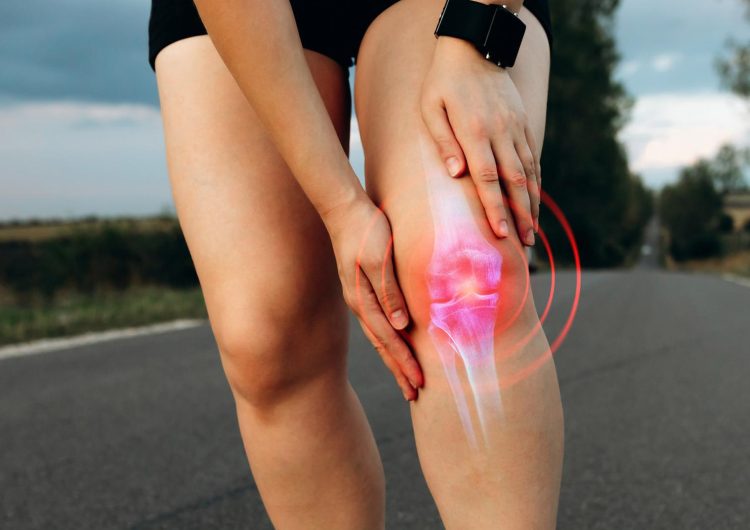Over my 10-year career as a strength and conditioning coach and Physical Therapist, I have helped clients look, move, and perform their best through individualized strength training programs.
During this time, I’ve realized that joints perform best when they are mobile and strong enough to withstand the demands of daily life.
However, joints can suffer from wear and tear over time, especially from a lifetime of sports and high-impact activities. Although I believe this to be the better of two evils and that being active is the best way to live a long and fulfilling life, these can still cause joint pain.
This article will explore how resistance bands can help you protect yourself from joint pain.
I will also provide some of my top resistance band exercises for you to incorporate into your workouts.
“Lowering orthopedic cost is about choosing more joint-friendly versions of similar patterns.” — Mike Boyle, Strength & Conditioning Coach
Get Fitter, FasterLevel Up Your Fitness: Join our 💪 strong community in Fitness Volt Newsletter. Get daily inspiration, expert-backed workouts, nutrition tips, the latest in strength sports, and the support you need to reach your goals. Subscribe for free!
What Causes Joint Pain?

Joint pain can occur for various reasons, including overuse, injury, arthritis, and high-impact repetitive activities. If the joints are not accustomed to this kind of activity, it can lead to an inflammatory response and joint pain.
Injuries such as sprains, strains, and fractures can also lead to joint pain. Resistance training too soon after injuries like these may delay healing. So, if you have sustained an injury, it would be best to seek guidance from a medical professional before you perform any exercise.
Conditions such as osteoarthritis, rheumatoid arthritis, and gout can also cause joint pain in older individuals due to inflammation, cartilage damage, or autoimmune responses.
As you age, you may also be at increased risk of developing joint pain due to joint stiffness and osteoarthritis.
Joint Instability
Joint instability refers to a lack of ability to control joint position during movement. It can often lead to feelings of weakness in the joint or the sensation that the joint may give way. (1)
Lumbar spine instability is common in the gym and is related to strength deficits in the core muscles and lumbar stabilizers (2). These deficits often lead to pain when bending or squatting.
Joint Stiffness
When a joint becomes stiff, moving through a full range of motion is difficult. This can be related to muscle tightness or stiffness in the joint capsule.
Joint stiffness can lead to discomfort in the actual joint or alter movement mechanics, which could affect the joints above and below.
Arthritis
Arthritis is among the most common sources of joint pain in older individuals (3). It is an inflammatory and degenerative condition that affects various joints.
Osteoarthritis is the most common cause of arthritis, which entails a breakdown of the hyaline cartilage between joints that cushion each bone’s ends. (3)
With time and use, this cartilage can wear down and expose the ends of the joints, causing inflammation and pain (3). Rheumatoid arthritis, however, is an autoimmune disorder that causes joint inflammation throughout the body. (4)
How Resistance Bands Protect You From Joint Pain
Here is how using resistance bands can help you avoid joint pain in the gym:
Lower Joint Stress
Repetitive high-impact movements can increase joint pain over time due to wear and tear on joints. They can also increase symptoms in those with osteoarthritis or existing joint issues.
Additionally, when these conditions are present, high-load strength training can be difficult because of joint compression.
Using resistance bands is a great way to reduce the joint impact of your workouts and prevent flare-ups in arthritic joints.
Variable Resistance
One key advantage of using resistance bands is that the exercise gets more challenging as the band stretches.
This is beneficial because the muscle’s leverage on the load changes as the joint angle changes, so the band can provide the right amount of resistance for the joint angle. With traditional dumbbell or barbell movements, the challenge on the target muscle can decrease as the joint angle closes.
For example, during a dumbbell bicep curl, the challenge increases as you reach a ninety-degree angle. But once you pass through the sticking point, the exercise gets easier.
Versatility
Resistance bands can be used in various ways to keep your strength training effective and interesting. Variation is one of the most important long-term strength and fitness development factors.
Exercises should be altered every few weeks to avoid accommodation and promote consistent improvements. Bands can be used for upper body exercises such as bicep curls and overhead presses and lower body movements such as good mornings and squats.
Level Up Your Fitness: Join our 💪 strong community in Fitness Volt Newsletter. Get daily inspiration, expert-backed workouts, nutrition tips, the latest in strength sports, and the support you need to reach your goals. Subscribe for free!
Plus, bands can also be combined with traditional strength training exercises such as bench presses or back squats to tweak the exercise’s resistance profile.
Activation of Joint Stabilizing Muscles
Resistance bands can be an excellent way to activate smaller joint-stabilizing muscles to help alleviate or avoid joint pain. For example, external and internal rotation exercises with a band can activate the rotator cuff muscle.
This would help strengthen the rotator cuff and improve its ability to stabilize the shoulder during overhead lifting.
Using a band can also add instability since the joints involved must work harder to stabilize as the movement is performed. In an exercise like an overhead press, the shoulders must coordinate to maintain a smooth motion.
This coordination may not happen to the same degree as an overhead press with a machine.
7 Top Banded Exercises For Joint Stability and Strength
Below are the top seven resistance band exercises I use as a physical therapist to protect my clients from joint pain:
Banded Strict Press
- With the feet shoulder-width apart, step on the band in its center.
- Hold the band with an overhand grip, just outside shoulder width, and assume a front rack position.
- Keep the glutes and core engaged and press the band overhead to full arm extension.
- Lower the band to the front rack position and repeat.
Joints stabilized:
- Shoulder joint
- Scapulothoracic joint
- Thoracic spine
- Elbow joint
Banded Push-Up
- Assume a push-up position with the band wrapped around your upper back.
- Lower your chest towards the floor, keeping the elbows from flaring.
- Touch the floor with the chest only and press back to the starting position.
- Maintain tension on the band throughout the movement.
Joints stabilized:
- Shoulder joint
- Scapulothoracic joint
- Lumbar spine
- Elbow joint
Banded Pendlay Row
- With the feet apart, stand on the band in its center.
- Hold the ends of the band with a neutral grip just outside shoulder width.
- Hinge at the waist so your torso is at 45 degrees.
- Retract the shoulder blades and pull the arms towards the body.
- Reverse direction and extend the arms to the starting position.
Joints stabilized:
- Shoulder joint
- Scapulothoracic joint
- Lumbar spine
- Elbow joint
Band Assisted Pull-Up
- Tie the band onto a pull-up bar.
- Place your foot or knee in the band and grip the bar just outside shoulder width.
- Retract the shoulder blades and pull the body up towards the bar.
- Continue pulling until the chin raises above the bar, then reverse direction.
Joints stabilized:
- Shoulder joint
- Scapulothoracic joint
- Elbow joint
Banded Squat
- Position your feet outside hip-width with a resistance band underneath the feet.
- Place the other end of the band across your shoulders.
- Descend into a squat by flexing the hips, knees, and ankles.
- Explode back to the standing position.
Joints stabilized:
- Lumbar spine
- Hip joint
- Knee joint
- Ankle Joint
Banded Goodmorning
- Assume a hip-width stance and step under the band so that it lays across your upper back.
- Grip the band on each side at waist level.
- With the weight in your heels, hinge at the hips and bow forward with a neutral spine.
- Continue dropping the chest until the torso is parallel to the ground.
- Once maximal tension is felt in the hamstrings and lower back, reverse direction.
Joints stabilized:
- Lumbar spine
- Hip joint
- Knee joint
Banded Pallof Press
- Tie the band to a pole or squat rack at mid-torso height.
- Hold the other end of the band with both hands.
- Extend the band in front of the body, resisting its pull towards the anchor.
- Hold for several seconds and return to the torso.
Joints stabilized:
- Lumbar spine
- Hip joint
- Glenohumeral joint
Resistance Band Training: Tips and Best Practices To Avoid Joint Pain
The following tips will help you get the most out of your workouts with resistance bands and keep you injury-free.
Choosing The Right Bands
Picking the right bands for your workouts depends on a few factors. For starters, you’ll want to determine which kinds of exercises you’ll be performing.
This is important since a squat or deadlift will require a different tension level than a lateral wall or scapular strengthening exercise since the muscles involved are stronger.
Next, you’ll need to determine the band length based on the exercises you’ll perform. For the same example above, a squat or deadlift would require a longer band because the exercises have a more extensive range of motion.
A short loop band would be more appropriate for lateral walks or scapular strengthening exercises.
Form Over Force
As with any exercise, it’s imperative to maintain good form throughout each exercise you perform. Exercises using a band are no different, and ignoring proper body alignment and joint angles can lead to negative forces on the joints involved, ultimately causing joint pain.
Before you worry about how much band tension you can use, ensure your technique is perfect and stays that way as you perform increased repetitions.
Progressive Overload
It is best to increase the band tension in a step-wise fashion to allow your muscles and tendons to acclimate to the load you’re placing on them. Doing so will help avoid overuse injuries to the tendons and joints themselves.
It will also help you build strength over time by adhering to the principle of linear periodization, where you do a little more work than last week. This could be more repetitions, more load, or more time under tension.
Whichever method you choose to progress week to week, doing so in a progressive manner will help you build strength consistently and safely.
Final Thoughts: Joint Pain and Resistance Training
If you have health and fitness goals, then training around joint pain can be frustrating. Often, conditions like osteoarthritis can be fickle in nature and wax and wane in intensity, with some exercises causing pain on certain days and others feeling perfectly fine.
Traditional strength training with high loads, such as dumbbells and barbells, can cause high levels of joint compression, further exacerbating joint pain.
However, using resistance bands can be a viable option for avoiding joint pain and achieving fitness goals. They provide a great way to challenge your muscles to become stronger, more defined, and more enduring, improving how you look, feel, and move.
If you want to avoid joint pain in your fitness training, grab yourself a band and give the exercises above a shot.
Let me know what you think about these exercises in the comments section below.
References:
- Wallace, D. T., Riches, P. E., & Picard, F. (2019). The assessment of instability in the osteoarthritic knee. EFORT open reviews, 4(3), 70–76.
- Puntumetakul, R., Saiklang, P., Tapanya, W., Chatprem, T., Kanpittaya, J., Arayawichanon, P., & Boucaut, R. (2021). The Effects of Core Stabilization Exercise with the Abdominal Drawing-in Maneuver Technique versus General Strengthening Exercise on Lumbar Segmental Motion in Patients with Clinical Lumbar Instability: A Randomized Controlled Trial with 12-Month Follow-Up. International journal of environmental research and public health, 18(15), 7811.
- Johnson, V. L., & Hunter, D. J. (2014). The epidemiology of osteoarthritis. Best practice & research. Clinical rheumatology, 28(1), 5–15.
- Smolen, J. S., Aletaha, D., & McInnes, I. B. (2016). Rheumatoid arthritis. Lancet (London, England), 388(10055), 2023–2038.









